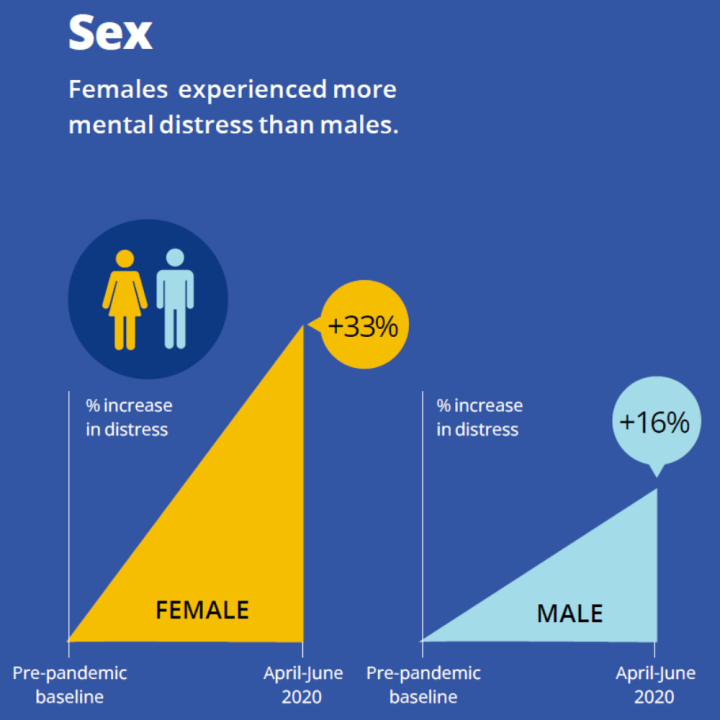Anxiety and depression due to the pandemic could remain for years
Levels of anxiety and depression remained high between lockdowns and worsened in the second lockdown, found researchers

The number of people suffering high levels of anxiety and depression rose by more than a third during the pandemic. It's a mental health crisis which looks likely to remain for years to come, according to a study using data from our volunteers and 10 other studies.
The research ran from March 2020 to March 2021. It investigated various stages of the pandemic, including two lockdowns and a period in which restrictions were eased. This data was then compared to data seven years before the Covid-19 pandemic.
The researchers were particularly concerned to find that the high levels of anxiety and depression they found early in the pandemic continued at similar levels, even after the first lockdown lifted. It then became worse during the second lockdown.
This suggests increased levels of mental health problems are likely to continue for some time, even though all restrictions have now been lifted, the researchers said.
The substantial deterioration in mental health seen in the UK during the first lockdown [from March to June, 2020] did not reverse when lockdown lifted, and a sustained worsening was observed across the pandemic
The study found a 29% increase in the number of people with psychological distress – an umbrella term for symptoms of anxiety and depression – from April to June 2020, compared to before the pandemic.
This rose to 36% compared to the pre-pandemic level between October 2020 and February 2021, with no notable reduction during the lifting of lockdowns in summer 2020.
The second lockdown ran from early November to early December 2020 and the third from early January to March 2021.
We found a sustained decrease in mental health. There was a lot of talk that lifting lockdown measures would automatically return people back to normal but our results suggest that wasn’t the case at all.
Given the sustained deterioration of mental health during the pandemic, I would think that it would still be sustained now [after the study period ended] and into the future. As long as the pandemic exists, I would say it’s highly likely that high psychological stress will continue
The study also found that women were more affected than men. It showed a 33% increase in the occurrence of mental distress in women from April to June 2020 compared to a 16% increase in men.
This is partly thought to be because women take on most of the extra caring duties. They also make up the bulk of the front-line healthcare workforce, who have been put under particular pressure by the pandemic.
People aged 25 to 44 experienced the sharpest decline in mental health across the pandemic. That could be because this age group is more likely to have children to care for and home school during lockdowns.
Researchers said that people in this age category were also more likely to experience mental distress anyway, regardless of the pandemic, compared to other age groups.
Given this, it is possible that psychological distress levels could go even higher in the future. However, that is a possibility rather than a prediction, Dr Kishan said.
The study was, sadly, unsurprising.
Many of us have found the pandemic very difficult to cope with for different reasons – including fears about getting sick, feelings of loneliness during lockdowns, concerns about finances and uncertainty about the future.
Recent estimates suggest there are 1.6million people waiting for mental health treatment and another eight million who could benefit from mental health services but aren’t deemed unwell enough to be eligible to access them.
We’ve all felt the sting of being separated from family and prevented from doing the things we love in the recent years, but this research shows that for many of us, the pandemic has taken a more severe toll.
Recovery won’t be linear, and as we now careen into a cost of living crisis and continue to deal with the aftershocks of the pandemic, it is vital that the government acts swiftly to ensure that people have access to the support they need.
This has to be a cross government approach to support people with aspects like housing, employment, finances and connecting with their communities, which we all need to be able to survive and to thrive.
The study was published in JAMA Network Open and funded by the Government’s UK Research and Innovation body. It looked at data from 49,993 people enrolled in 11 separate studies, including Generation Scotland volunteers, who responded to surveys about their mental health before and during the pandemic.
Before the pandemic, about 10 - 20% of volunteers met the criteria for mental distress. This proportion varied from one study group to the next.
The study involved the universities of Bristol, Glasgow and Edinburgh, and the Bradford Institute for Health Research and the full publication can be found below:
This article was adapted from the 'i' news article. The original article can be found below.

